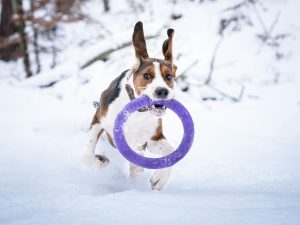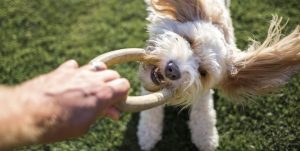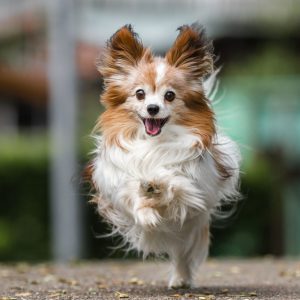Welcome to the world of doggy fun and games! As pet owners, we all want to see our furry friends happy, healthy, and entertained. One of the key ingredients to achieving this is ensuring they get the right amount of mental and physical stimulation. Just like us, dogs need activities to keep their minds sharp and their bodies active.
In this blog post, we’re diving into the exciting world of toys and games for dogs. From interactive puzzles to outdoor adventures, we’ll explore a variety of engaging activities that will keep your canine companion entertained for hours on end. So, get ready to unleash the fun as we delve into the wonderful realm of doggy playtime!

Understanding Your Dog’s Needs
When it comes to keeping your dog happy and fulfilled , understanding their individual needs is key. Every dog is unique, and factors such as breed, age, and personality play a significant role in determining the types of activities they’ll enjoy. Here’s a closer look at why understanding your dog’s needs is essential:
- Breed Characteristics : Different dog breeds have different instincts and tendencies. For example, herding breeds may enjoy activities that engage their natural herding instincts, such as fetching or agility courses. Understanding your dog’s breed can help you tailor activities that align with their innate preferences.
- Age Considerations: Just like humans, dogs’ activity levels and preferences can change as they age. Puppies may have boundless energy and enjoy playful activities like tug-of-war or chasing balls, while senior dogs may prefer more gentle forms of exercise, such as leisurely walks or puzzle games.
- Personality Traits: Every dog has its own unique personality, which can greatly influence the types of activities they enjoy. Some dogs may be highly social and thrive in group play settings, while others may prefer solitary activities or one-on-one interaction with their owners.
By taking into account your dog’s breed, age, and personality, you can better understand their needs and preferences when it comes to enriching activities. This knowledge will guide you in selecting the most suitable toys and games to keep your furry friend happy and engaged.
Interactive Toys for Mental Stimulation
Interactive toys are a fantastic way to provide mental stimulation for your dog while also keeping them entertained. These toys engage your dog’s problem-solving skills and offer a fun and rewarding experience. Here’s a closer look at some popular interactive toys:
- Puzzle Toys : Puzzle toys come in various shapes and sizes and are designed to challenge your dog’s cognitive abilities. They typically involve hiding treats or kibble inside compartments that your dog must figure out how to access. As your dog interacts with the toy, they are rewarded with tasty treats, keeping them engaged and mentally stimulated.
- Treat Dispensers: Treat dispensers are toys that dispense treats or kibble when manipulated by your dog. Some treat dispensers require your dog to roll or paw at the toy to release the treats, while others may involve pushing buttons or flipping lids. These toys encourage your dog to problem-solve and work for their rewards, providing mental stimulation and entertainment.
- Interactive Games : There are numerous interactive games available that allow you to engage with your dog in fun and stimulating activities. From hide-and-seek games to interactive fetch toys, these games promote bonding between you and your dog while also providing mental exercise. Interactive games also help reinforce training commands and encourage positive behaviors.
The benefits of interactive toys for dogs are plentiful. Not only do they prevent boredom and alleviate stress and anxiety, but they also promote mental stimulation and problem-solving skills. By incorporating interactive toys into your dog’s routine, you can ensure they stay mentally sharp and satisfied.
Chew Toys for Dental Health

Chew toys play a crucial role in maintaining your dog’s dental health while also providing an outlet for their natural chewing instincts. Here’s why chew toys are essential for your dog’s well-being:
- Dental Health Benefits: Chewing on appropriate toys helps remove plaque and tartar from your dog’s teeth, promoting good oral hygiene and reducing the risk of dental problems such as periodontal disease. The act of chewing also stimulates saliva production, which can help neutralize acids in the mouth and prevent the formation of cavities.
- Prevention of Destructive Chewing: Dogs have an innate need to chew, and providing them with suitable chew toys can prevent them from resorting to destructive chewing behaviors, such as chewing on furniture, shoes, or other household items. By offering an enticing alternative, you can redirect your dog’s chewing behavior towards more appropriate outlets.
- Selection of Durable and Safe Toys: When choosing chew toys for your dog, it’s essential to select options that are durable and made from safe materials. Opt for toys that are specifically designed for chewing and are resistant to damage from your dog’s teeth. Additionally, consider your dog’s size and chewing strength when selecting the appropriate toy to ensure it can withstand their chewing habits without posing a choking hazard.
- Variety for Different Sizes and Breeds: Dogs come in various sizes and breeds, each with different chewing preferences and needs. It’s essential to provide a variety of chew toys to cater to these differences and keep your dog engaged. For example, larger breeds may require more robust chew toys, while smaller breeds may prefer softer options. By offering a range of toys, you can ensure there’s something suitable for every dog.
By incorporating chew toys into your dog’s daily routine, you can help maintain their dental health, prevent destructive chewing behavior, and keep them mentally and physically stimulated. Be sure to supervise your dog when introducing new toys and regularly inspect them for signs of wear and tear to ensure they remain safe and effective.
Outdoor Games for Physical Exercise
Outdoor games are a fantastic way to provide your dog with both physical exercise and mental stimulation. Here are some popular outdoor games that you can enjoy with your furry friend:
- Fetch: Fetch is a classic game that dogs love to play. It’s simple yet effective in providing both physical activity and mental stimulation. All you need is a ball or a Frisbee, and you’re ready to go. Start by throwing the object a short distance and gradually increase the distance as your dog becomes more confident. Not only does fetch provide a great workout for your dog’s muscles, but it also engages their mind as they focus on retrieving the object.
- Tug-of-War: Tug-of-war is another favorite game for many dogs. It’s an excellent way to burn off excess energy and engage in some healthy competition. Use a sturdy rope or tug toy and encourage your dog to grab onto one end while you hold onto the other. Gently tug back and forth, being mindful not to pull too hard to avoid injury. Tug-of-war helps strengthen your dog’s jaw muscles and provides an outlet for their natural instinct to pull and tug.
- Agility Training: Agility training involves navigating your dog through a series of obstacles, such as tunnels, jumps, weave poles, and ramps. Not only does agility training provide physical exercise, but it also challenges your dog’s problem-solving skills and enhances their coordination and balance. You can set up a simple agility course in your backyard using household items or invest in agility equipment for more advanced training. Remember to start slowly and gradually increase the difficulty level as your dog becomes more proficient.
When engaging in outdoor games with your dog, it’s essential to create a safe and stimulating environment. Here are some tips to ensure a fun and enjoyable experience:
- Secure the Area: Make sure the outdoor area is securely fenced to prevent your dog from wandering off and ensure their safety.
- Check the Weather: Avoid playing outdoor games during extreme weather conditions, such as extreme heat or cold, to prevent discomfort or health risks for your dog.
- Provide Shade and Water : Offer plenty of shade and fresh water to keep your dog cool and hydrated during outdoor play sessions.
- Supervise Your Dog: Always supervise your dog during outdoor activities to ensure their safety and intervene if necessary.
- Use Positive Reinforcement: Use positive reinforcement techniques, such as treats and praise, to encourage good behavior and reinforce training during outdoor games.
By incorporating outdoor games into your dog’s routine, you can provide them with the physical exercise and mental stimulation they need to stay happy, healthy, and well-balanced. So grab your outdoor gear and get ready for some fun adventures with your canine companion!

DIY Toys and Games
Engaging in do-it-yourself (DIY) projects to create toys and games for your dog can be a rewarding and cost-effective way to provide entertainment and mental stimulation. Here are some creative ideas for homemade toys and games using household items:
- Tug Toys : Repurpose old t-shirts, towels, or denim jeans into tug toys by cutting them into strips and braiding or knotting them together. These homemade tug toys provide a durable and interactive option for playing tug-of-war with your dog, promoting bonding and strengthening their jaw muscles.
- Tennis Ball Treat Dispenser: Cut a small slot in a tennis ball and fill it with your dog’s favorite treats or kibble. As your dog rolls the ball around, the treats will dispense intermittently, providing mental stimulation and encouraging problem-solving skills. This homemade treat dispenser is an excellent way to keep your dog entertained and engaged during playtime.
- Cardboard Box Puzzle: Gather several cardboard boxes of different sizes and shapes and place treats or toys inside them. Close the boxes and scatter them around the room or yard. Encourage your dog to use their nose and paws to open the boxes and retrieve the hidden treasures inside. This DIY puzzle game stimulates your dog’s sense of smell and encourages exploration and problem-solving.
- Frozen Treats: Create homemade frozen treats for your dog by mixing plain yogurt with mashed banana or pureed fruit and pouring the mixture into ice cube trays or silicone molds. Add a few pieces of dog-friendly fruits or vegetables, such as blueberries or carrots, for added flavor and nutrition. Freeze the treats until solid, then offer them to your dog as a refreshing and healthy snack during hot summer days.
- Scented Sock Toys: Fill a clean sock with dried herbs, such as lavender or chamomile, or sprinkle it with a few drops of essential oil (diluted with water) known to have calming effects on dogs, such as lavender or chamomile. Tie a knot at the open end to secure the contents. These scented sock toys can provide comfort and relaxation for dogs, especially during times of stress or anxiety.
Engaging in DIY projects to create toys and games for your dog not only stimulates their mind and body but also strengthens the bond between you and your furry friend. By using household items creatively, you can provide endless opportunities for enrichment and entertainment while saving money on store-bought toys. So gather your materials and let your imagination run wild as you embark on fun and rewarding DIY adventures with your canine companion!
Age-Appropriate Activities

Tailoring activities to your dog’s age is essential for providing appropriate mental and physical stimulation while ensuring their safety and well-being. Here’s a breakdown of age-specific activities for puppies, adult dogs, and senior dogs:
- Puppies: Puppies have boundless energy and a natural curiosity about the world around them. Engage them in activities that promote socialization, exploration, and gentle exercise. Some age-appropriate activities for puppies include:
- Socialization Outings: Take your puppy on short outings to introduce them to new environments, people, and animals. Visit parks, pet-friendly stores, and puppy playgroups to help them develop confidence and positive associations with new experiences.
- Basic Training Sessions: Start basic obedience training early to establish good behavior habits and strengthen the bond between you and your puppy. Focus on commands like sit, stay, and come, using positive reinforcement techniques such as treats and praise.
- Puzzle Toys and Interactive Games: Provide puzzle toys and interactive games that challenge your puppy’s problem-solving skills and keep them mentally stimulated. These activities help prevent boredom and encourage independent play.
Adult Dogs:
- Adult dogs typically have lower energy levels than puppies but still require regular exercise and mental stimulation to stay happy and healthy. Tailor activities to suit your dog’s interests, preferences, and physical abilities. Some age-appropriate activities for adult dogs include
- Outdoor Adventures: Take your dog on regular walks, hikes, or runs to provide physical exercise and mental enrichment. Explore new trails or parks to keep things interesting and stimulating for your dog.
- Interactive Play Sessions: Engage in interactive play sessions with your dog using toys like balls, frisbees, or tug ropes. Play fetch, hide-and-seek, or other games that tap into your dog’s natural instincts and instincts.
- Training and Brain Games: Continue to challenge your dog’s mind with training sessions and brain games that reinforce obedience skills and problem-solving abilities. Teach them new tricks or introduce scent games to keep their minds sharp and engaged.
Senior Dogs:
- Senior dogs may have lower energy levels and mobility issues due to age-related changes, but they still benefit from gentle exercise and mental stimulation. Adjust activities to accommodate your senior dog’s needs and comfort levels. Some age-appropriate activities for senior dogs include:
- Low-Impact Exercise: Take leisurely walks or short strolls around the neighborhood to provide low-impact exercise for your senior dog. Choose flat, even surfaces to prevent joint strain and discomfort.
- Gentle Training and Enrichment: Engage in gentle training sessions and enrichment activities that cater to your senior dog’s abilities and interests. Practice basic commands or engage in scent games that tap into their senses and cognitive abilities.
- Comfort and Relaxation: Create cozy and comfortable spaces where your senior dog can relax and unwind. Provide soft bedding, elevated beds, and quiet areas where they can rest without disturbance. Offer massage or gentle grooming sessions to promote relaxation and bonding.
Adapting activities to suit your dog’s age ensures they receive appropriate mental and physical stimulation while promoting their overall well-being and quality of life. By understanding and accommodating your dog’s changing needs as they age, you can continue to provide them with fulfilling and enriching experiences throughout their lives.
Supervision and Safety
Ensuring the safety of your dog during playtime is paramount to prevent accidents and injuries. Here are some important considerations to keep in mind:
- Supervision: Always supervise your dog during playtime, especially when they are engaging in activities with toys or interacting with other dogs. This allows you to intervene quickly if any potential hazards arise and ensures a safe and enjoyable experience for your dog.
- Choosing Safe Toys: Select toys that are specifically designed for dogs and are appropriate for your dog’s size, age, and chewing habits. Avoid toys with small parts that could be easily swallowed or choked on, as well as toys made of materials that could splinter or break apart.
- Inspecting Toys: Regularly inspect your dog’s toys for signs of wear and tear, such as frayed edges, loose parts, or damage. Replace any damaged toys immediately to prevent your dog from ingesting or choking on pieces.
- Avoiding Toxic Materials: Be cautious when choosing toys and avoid those made with toxic materials or chemicals that could be harmful to your dog if ingested. Opt for toys made from safe and non-toxic materials, such as natural rubber or durable plastics.
- Safe Play Areas: Create a safe and secure play area for your dog, free from potential hazards such as sharp objects, toxic plants, or electrical cords. Remove any small objects or obstacles that could pose a choking or tripping hazard to your dog during playtime.
- Monitoring Interactions: Pay close attention to how your dog interacts with toys and other dogs during playtime. Watch for any signs of aggression, resource guarding, or rough play that could lead to injuries. Intervene if necessary to prevent conflicts and ensure a positive play experience for all dogs involved.
By prioritizing supervision and safety measures during playtime, you can help prevent accidents and injuries while promoting a fun and enriching experience for your dog. Remember to always prioritize your dog’s well-being and provide a safe environment for them to play and exercise.

Rotating Toys for Variety
Introducing variety into your dog’s toy collection can help keep them engaged and prevent boredom. Here’s why rotating toys is beneficial and how to do it effectively:
- Maintaining Interest: Dogs can quickly become bored with their toys if they are always available. By rotating toys regularly, you can keep your dog’s interest piqued as they discover new toys and activities.
- Preventing Boredom: Boredom can lead to destructive behaviors and excessive chewing. Rotating toys provides mental stimulation and keeps your dog entertained, reducing the likelihood of boredom-related issues.
- Suggested Rotation Schedule: Consider implementing a toy rotation schedule to ensure variety. For example, you could rotate toys weekly or every few days, depending on your dog’s preferences and the size of their toy collection.
- Storage Solutions: To keep toys organized and easily accessible, invest in storage solutions such as toy bins, baskets, or toy chests. Designate a specific area in your home where you can store and rotate toys, making it convenient to swap them out regularly.
- Mixing Toy Types: Include a variety of toy types in your rotation, such as chew toys, plush toys, puzzle toys, and interactive toys. This offers different textures, shapes, and activities to keep your dog engaged and stimulated.
- Observing Preferences: Pay attention to your dog’s preferences and reactions to different toys. Some toys may be more appealing than others, so rotate based on what keeps your dog engaged and entertained.
- Monitoring Wear and Tear: Regularly inspect toys for signs of wear and tear, and discard any damaged toys that could pose a safety hazard to your dog. Replace worn-out toys with new ones to maintain variety in your rotation.
By rotating toys regularly and providing a variety of options, you can keep your dog mentally stimulated, physically active, and entertained. Experiment with different toys and rotation schedules to find what works best for your dog’s individual preferences and needs.
Monitoring Your Dog’s Enjoyment
Observing your dog’s behavior and preferences during playtime is crucial for ensuring they are engaged and enjoying themselves. Here’s how to monitor your dog’s enjoyment and adjust activities accordingly:
- Watch Their Body Language: Pay attention to your dog’s body language while they play. Signs of enjoyment may include wagging tails, play bows, and relaxed body postures. Conversely, signs of stress or discomfort may include tense body language, flattened ears, and avoidance behaviors.
- Observe Toy Preferences: Take note of which toys your dog gravitates towards and how they interact with them. Some dogs may prefer certain textures, shapes, or types of toys over others. Rotate toys regularly and observe which ones your dog shows the most interest in.
- Adjust Activities: Be flexible and willing to adapt activities based on your dog’s feedback. If your dog loses interest in a particular game or toy, try switching to a different activity or offering a new toy to reignite their enthusiasm.
- Provide Positive Reinforcement: Use positive reinforcement, such as praise, treats, or favorite toys, to reward your dog’s engagement and enjoyment during playtime. This reinforces positive behaviors and encourages continued participation.
- Respect Their Limits: Every dog has their own energy levels and preferences when it comes to play. Pay attention to cues that indicate when your dog needs a break or is becoming overstimulated. Allow them to rest and recharge as needed to prevent exhaustion or frustration.
- Rotate Activities: Offer a variety of activities to keep your dog mentally and physically stimulated. Mix up games of fetch, tug-of-war, hide-and-seek, and puzzle toys to provide diversity and prevent boredom.
- Consult with a Professional: If you’re unsure about your dog’s enjoyment or behavior during playtime, consider consulting with a professional dog trainer or behaviorist. They can offer personalized advice and guidance based on your dog’s individual needs and preferences.
By closely monitoring your dog’s enjoyment and adjusting activities accordingly, you can ensure they have a fulfilling and enjoyable playtime experience. Pay attention to their cues, be responsive to their needs, and provide a variety of engaging activities to keep them happy and entertained.
Conclusion
In conclusion, engaging activities and toys play a vital role in keeping your dog happy and healthy. By providing mental stimulation and physical exercise, these activities contribute to your dog’s overall well-being and quality of life. Here’s a summary of the key benefits:
- Mental Stimulation: Interactive toys, puzzle games, and DIY activities challenge your dog’s problem-solving skills and keep their mind engaged. This mental stimulation helps prevent boredom and can alleviate behavioral issues caused by pent-up energy or frustration.
- Physical Exercise: Outdoor games like fetch, tug-of-war, and agility training provide essential physical exercise for your dog. Regular exercise helps maintain a healthy weight, strengthens muscles, and promotes cardiovascular health.
- Bonding and Socialization: Playtime offers valuable opportunities for bonding between you and your dog. Whether you’re playing together with toys or engaging in interactive games, these shared experiences strengthen your relationship and enhance communication.
- Dental Health: Chew toys not only provide entertainment but also contribute to your dog’s dental health. Chewing helps remove plaque and tartar buildup, reducing the risk of dental problems such as gum disease and tooth decay.
- Emotional Well-being: Playtime and enrichment activities fulfill your dog’s natural instincts and provide emotional fulfillment. Dogs thrive on interaction, exploration, and play, and these activities fulfill their innate need for stimulation and companionship.
Incorporating engaging activities and toys into your dog’s daily routine is essential for their physical, mental, and emotional well-being. As responsible pet owners, we should prioritize playtime and enrichment activities to ensure our dogs lead happy, fulfilled lives.
Remember to observe your dog’s enjoyment and preferences during playtime, and adjust activities accordingly. By providing a variety of stimulating toys and activities, you can keep your dog entertained, mentally stimulated, and physically active.